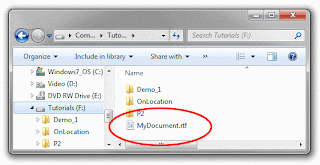This post shows you how to change the name of a file extension in Windows. For example, you might want to change a file called mypage.htm to mypage.php, or myvideo.vob to myvideo.mpg. These instructions are the basic process applies to most versions of Windows
NOTE: Changing a file extension should only be done if you are confident it's the right thing to do. When you change an extension, one of three things is likely to happen:
- It won't make any difference to how the computer deals with the file.
- It will enable some programs to recognize and work with a file, while other programs may no longer recognize it.
- It will not have any useful effect and the file will no longer open properly.
WINDOW 7
My Computer
The first thing to do is open Windows Explorer (or My Computer) and view the file you wish to change. We'll use the example of a file called MyDocument.rtfwhich we want to change to MyFile.txt. When we browse to the file it looks like this:
You'll notice that the file does not appear to have an extension — it's just called MyDocument.rtf. This is because Windows is set to hide extension names. Go to organize > Folder and Search Options, then click the View tab. Uncheck the box titled "Hide extensions for known file types" like so:
Click OK or Apply. Now you should be able to see the file extension:
Right-click the file name and select Rename (or left click and hold down the button for one second). Enter the new extension like so:
After entering the new extension, hit the Enter (return) key. Windows will give you a warning that the file may not work properly. This is quite safe — if the file does stop working you can always change the extension back (just make sure you remember what it was!).
It's also possible that you might get another message telling you that the file is "read-only". In this case either say yes to turning off read-only, or right-click the file, select Properties and uncheck the Read-only box.
If you do not have permission to change the file extension, you may have to login as Administrator. Another option is to make a copy of the file, rename the copy and then delete the original.
Note: Windows treats file extensions as case-insensitive, i.e. .RTF is the same as .rtf. However other operating systems do not, and will treat MyDocument.RTFand MyDocument.rtf as two different files. Therefore it is good practice to always treat your files as case-sensitive for maximum compatibility. This is especially crucial if you are going to use the files on the Internet. We strongly recommend that you get into the habit of using all lower-case letters for all file extensions.
WINDOW XP
Windows Explorer
The first thing to do is open Windows Explorer (or My Computer) and view the file you wish to change. We will use the example of a file called myfile.rtf which we want to change to myfile.txt. It looks like this in Windows Explorer:
At this stage you might notice that your file does not appear to have an extension (in the above example it would simply be called myfile). This is probably because you have Windows set to hide extension names. Go to Tools > Folder Options, then click the View tab. Uncheck the box titled "Hide extensions for known file types" like so:
Click OK. Now you should be able to see the file extensions for all files. Right-click the file name and select Rename. Enter the new extension like so:
After entering the new extension, hit the Enter (return) key. Windows will give you a warning that the file may not work properly. This is quite safe — if the file does stop working you can always change the extension back (just make sure you remember what it was!).
If you get another message telling you that the file is "read-only" and asking if you want to turn read-only off, say yes.






No comments:
Post a Comment